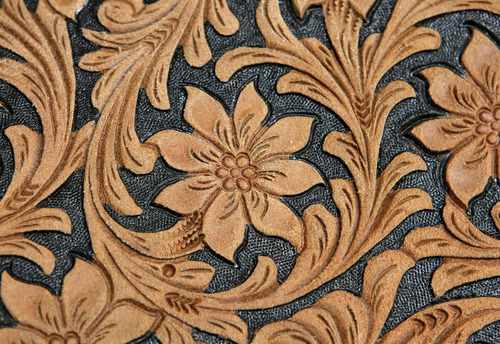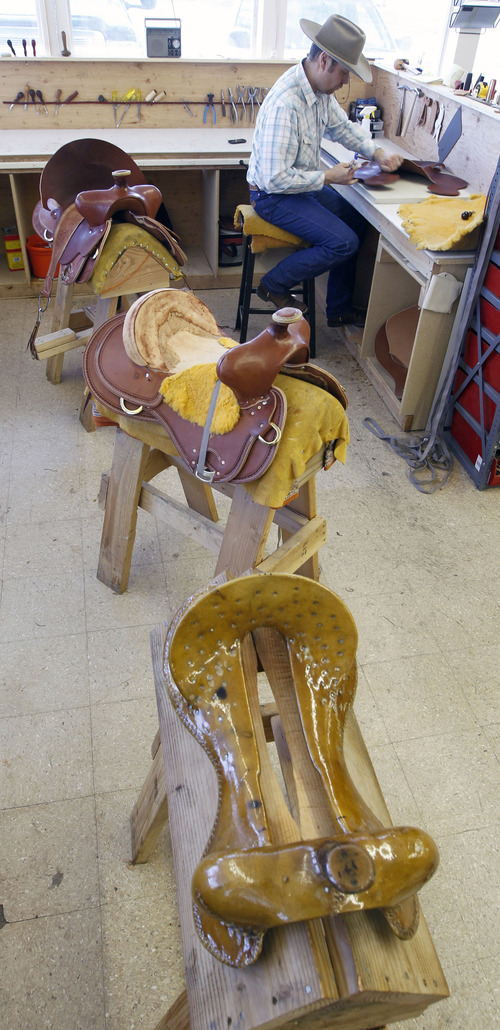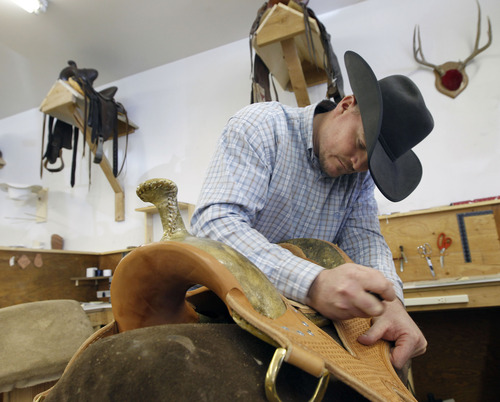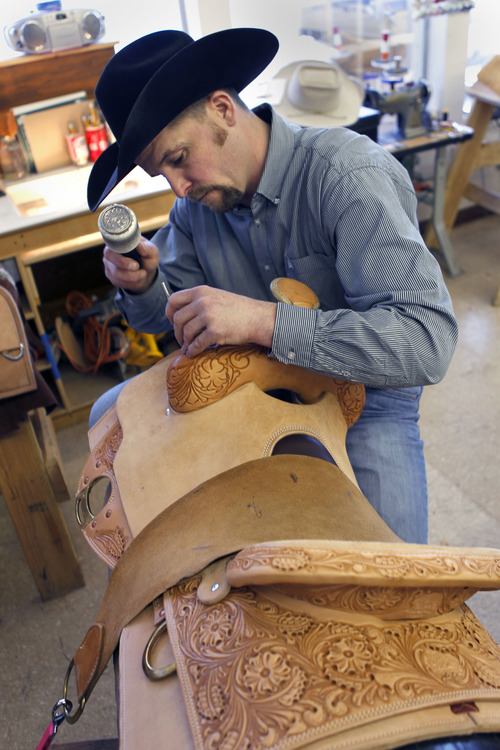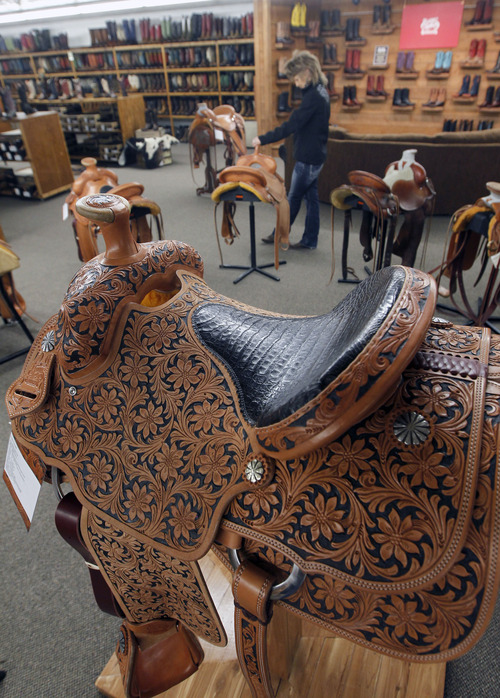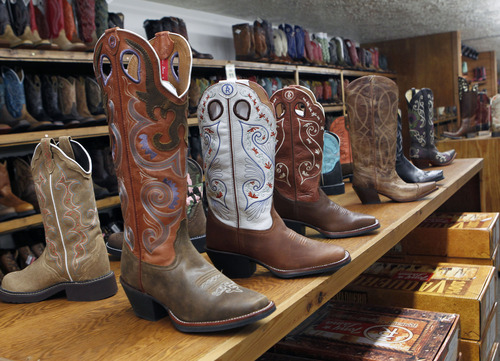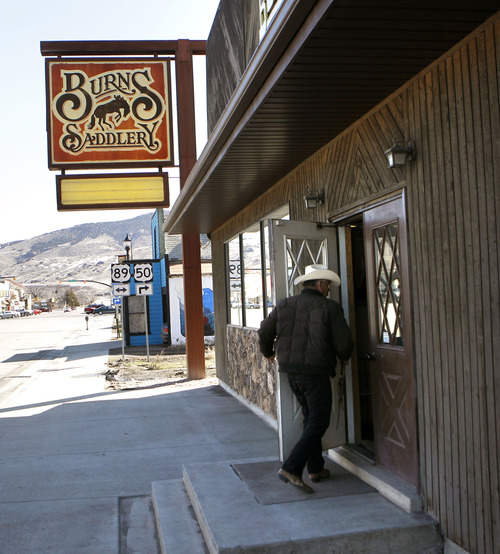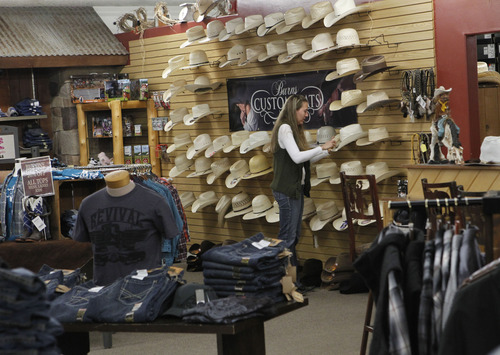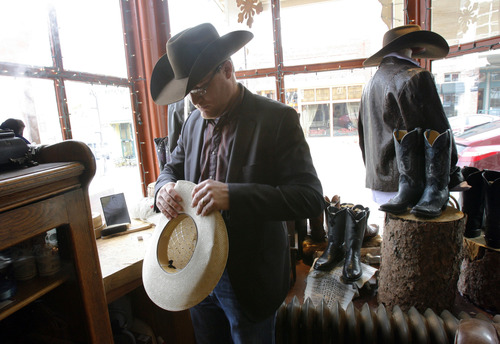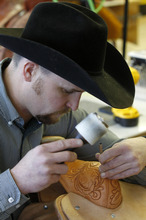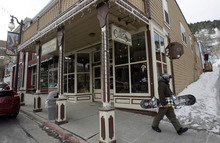This is an archived article that was published on sltrib.com in 2013, and information in the article may be outdated. It is provided only for personal research purposes and may not be reprinted.
Salina • Utah was a territory when cowboy Miles "Moen" Burns opened a harness shop in the high desert hamlet of Loa nearly 140 years ago.
Son Viv moved the shop 50 miles north to Salina, named for its salt deposits, and by 1912 business was so brisk that he purchased a foot-powered harness stitcher to keep up with the work.
Anyone who has ever driven U.S. 89 knows Burns Saddlery, guarded by a mounted horse above the door, and now sitting across the street from the original Salina store. The area is so isolated that the 110 miles between Salina and Green River makes up one the longest distances in the U.S. Interstate Highway System with no motorist services.
Despite long travel times, the Burns family-owned emporium, 135 miles south of Salt Lake City, is a central Utah institution. Here, equestrians buy saddles, tack and Western wear. The store stocks 5,000 pairs of cowboy boots — about 2,600 more than there are Salina residents.
The saddlery, with its imprint in three centuries, has adapted to changing ways.
Working ranchers and farmers still frequent Burns Saddlery, but they've been joined by weekend riders, circuit cowboys and show-horse enthusiasts. A second saddlery shop opened last November in Lehi — just south of the Roller Mills — to attract equestrians along the populous Wasatch Front and beyond.
"Burns isn't cheap," said reining competitor Cori Timm, from Spring Creek, Nev., who recently stopped by the Lehi store to pick up a wide-brimmed, black cowboy hat. "But here, you only have to buy something once."
—
Beyond tradition • Equestrian events, from rodeos to horse shows, are big business for participants and for the firms that supply the saddles and tack.
Last year, prize money totaled more than $6 million during the National Finals Rodeo in Las Vegas, organized by the Professional Rodeo Cowboys Association. Tickets for the 10-day event have sold out for the past 25 years, with the economic impact to Las Vegas (excluding gambling receipts) topping $60 million annually. The association also organizes 12 rodeos in Utah, from Logan to St. George, including the Days of '47 rodeo in Salt Lake City.
Burns has expanded beyond its traditional saddleries, opening exclusive Cowboy Shops in Park City and Carmel-by-the Sea in California, where resort shoppers can buy an artisan-created piece of the Old West. The company remains close to its roots, attracting employees familiar with horses and equestrian events. But high-end shoppers sometimes miss the message.
Park City tourists frequently compliment sales manager Jake Quanberg on his "costume" that looks so similar to the ones they've seen in countless Western movies. Quanberg gives a friendly nod in return, not mentioning that he grew up on a cattle ranch in Lost Creek, so small that it's not found on most maps (it's just off Sage Flat Road, down the road from Salina).
"You either hate the life or you can't get it out of your system," said Quanberg, who remembers as a boy shopping at the Burns store in Salina, where he returns each year to help with the fall roundup.
Said Park City shop manager Jeena Woolstenhume: "Most of the people who come into the store have never been on a horse, but they love the West and want to wear what we wear."
—
Spirit of the West • The resort stores are radically different from the saddlery shops in Salina and Lehi. But the concept seems to be working, with revenue over five years growing 135 percent, divided equally between its saddlery and resort stores, said company officials.
Resort-store items must have a "wow" factor, such as a butterfly buckle, hand tooled from woolly mammoth tusk and encrusted with fiery opal, emerald turquoise, sapphires, rubies and yellow diamonds.
And only the more affluent could afford the highest-end boots, handmade from exotic leathers, including giraffes, hippo, saltwater crocodile and elephant (inspected and cleared as legal by the U.S. Fish and Wildlife Service and Customs), as well as ostrich, alligator, python and stingray. Prices start at $400, up to several thousands of dollars.
"Most of these boots will never see a stirrup — but they could," said Woolstenhume, who grew up on a Utah County quarter-horse ranch, Cross Quarter Circle.
By contrast, boots at the Salina and Lehi saddleries are made from leathers popular among Western riders, such as bison and cow hides. The boots also are sturdy enough for truck drivers hauling coal from the Sufco mine in Sevier County, and popular enough to be the first pair of shoes for many country toddlers.
"The spirit of the West is seeking a better life," said CEO Danna Burns Shaw. "I love to show our culture; it's a way of keeping it intact."
The 53-year-old Shaw grew up in Salina, living upstairs from the saddle shop, and often visited tanners with her late father, "so I know what it takes to make fine, high-quality leather."
Shaw, a fifth-generation owner, has guided the company from its saddle and tack origins toward designer Western wear. She also designs boots with the Burns private label or under commission with the nationally known Texas-based Lucchese Boot Co.
Twenty years ago, she and husband Scott Shaw expanded beyond their hometown, hauling saddles and tack from California to Texas and selling them at cutting-horse competitions, reining events and rodeos. On the road, they met dozens of artisans who made Western wearable art, one-of-a-kind accessories and museum-quality jewelry, which led to opening the company's first resort store in 2008.
"We were developing our own branded products and we knew many amazing artists, but we needed a great environment to display what we had," she said. "We decided that Park City was the winning combination. It's one thing to design and another to create. But you also need a place and a great salesperson to show it."
Encouraged by sales receipts, the Shaws opened a second Burns Cowboy Shop in 2010 at Carmel-by-the-Sea.
The shops stock creations from about 100 artisans, as well as products manufactured in the Burns plants in Salina, where chaps, belts, hats and saddles are made.
—
Along for the ride • Two-time World Champion team roper Matt Sherwood got his first Burns saddle three years ago before the company began sponsoring him. Sherwood, who competes in the Professional Rodeo Cowboys Association circuit, has since gotten two more Burns saddles.
"They start with a great tree [saddle skeleton]," said Sherwood from his Pima, Ariz., home. "And they have great quality leather. I've had some problems in the past, but with them, I don't have to worry about the quality of my saddle."
Burns saddles cost from $3,000 to $8,000, depending on the level of detail in the artwork. Saddles have more than 50 pieces, which are put together over a 40-hour to 150-hour period. Artisan-made saddles can take much more time to construct, and cost tens of thousands of dollars more, but most are considered decorative, although they could be used on a horse.
All are Western saddles, designed for riders spending long hours on a mount and traveling over rugged terrain. Saddles also have variations to accommodate specific tasks, such as cutting, barrel racing or endurance competitions. Most saddles are custom made and all are hand tooled.
"We want our customers to be involved in the whole process," said head saddle maker Matt Wanner. "It's got to fit the horse and it's got to fit the rider."
With care, saddles can last a lifetime — or longer.
Aurora rancher Rick Nelson said taking his grandfather's 100-year-old saddle into Burns to be refurbished was akin to entrusting a prized antique car to a mechanic. The saddle is heavy, patched, and the maker's stamp has long worn away, but it's so durable that Nelson has used it since he was 13 years old.
"My buddies ask when I'm going to get a new saddle," said Nelson, who has appeared on the "Survivor" reality television show. "But this one's comfortable — the old ones were made for guys to sit in them for 12 to 16 hours in a day. I use this one all the time."
—
Hats off • Burns also makes custom hats, which can cost from $299 to $899, depending on the amount of beaver fur used in the blend.
Production manager Zane Osborn said the size of the hat's brim and creases in the crown vary, depending on the horse event and the region. For instance, domed crowns and wider brims are often preferred by rough-stock riders, while ropers are partial to rolled brims. Some Nevada customers like flat brims, while Californians like distressed hats that look weather beaten and old.
The shop also refurbishes them, such as the battered hats sent in by the brothers Jake, Cody and Jesse Wright, saddle bronc riders from Milford. Jake Wright said he has two Burns hats. Whenever he gets thrown and his hat gets smashed, "I send it in. I usually have one with me and the other in the shop at any one time."
In December, Wright captured his first world title in the National Finals Rodeo. Despite being bucked off three times, he finished the season with earnings of $226,886.
Burns Saddlery has a following on the circuit, selling saddles and tack, and depends on word of mouth for much of its business there, said company president Braydan Shaw. "When you've been around for more than a century," he added, "people know who you are."
Along with the circuit and its four stores, Burns' goods are sold at the Saddlery Cowboy Bar & Steakhouse in Torrey, near the west entrance to Capitol Reef National Park. The agreement with Burns in redrock country could be called a sentimental choice. The bar is only 15 miles south of Loa, site of the first Burns shop.
Twitter: @DawnHouseTrib —
Burns Cowboy & Saddlery Shops
Founded • 1876
Saddle, chaps, hat plant • Salina
Cowboy resort shops • Park City, 363 Main St.; and Carmel, Calif.
Saddlery shops • Salina, 79 W. Main St.; and Lehi, 310 N. 850 East
Workforce • 40 employees, 100 independent artisans
Retail • Boots, hats, Western wear, jewelry, saddles —
Cowboy hats
Spanish influence was so great that some 19th-century catalogs called them "sombreros." Here's a sampling of styles:
Stetson • A rolled brim with high crown dating to manufacturer John Stetson,1865
Montana Peak • Pinched crown with smaller brim to combat wind, 1920s
Texas • Wide brim with tall crown to keep heads cool, 1910-1920
Ten Gallon • Made for movie stars Jack Hoxie, Tim McCoy and Tom Mix, 1925-1930
Roper • A flat but slightly dipped brim, worn by World Champion roper Bob Crosby, 1925
Rodeo • Wide brim with low crown popularized by movie horse trainers, 1955-1960
Cattleman • Owners preferred the smaller brim than those of working cowboys, 1965-1975
Source: National Cowboy & Western Heritage Museum


